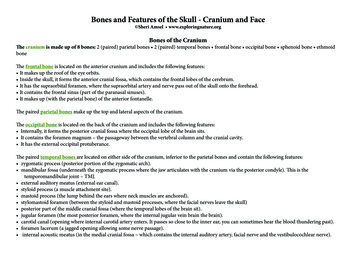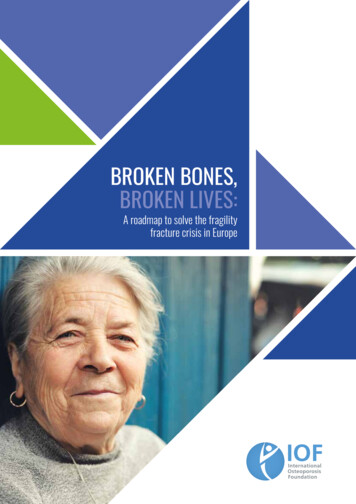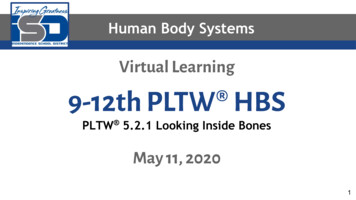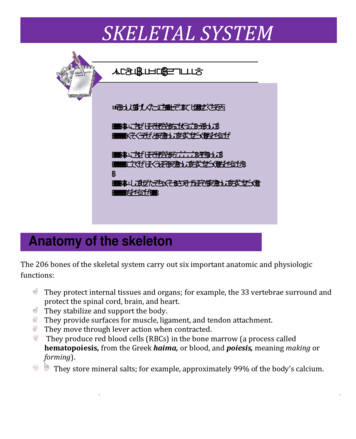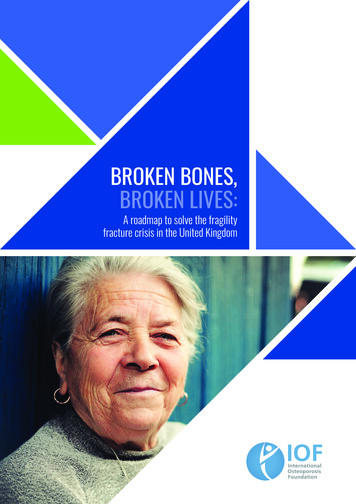
Transcription
BROKEN BONES,BROKEN LIVES:A roadmap to solve the fragilityfracture crisis in the United Kingdom
FOREWORDWith fragility fractures affecting one in three womenand one in five men aged 50 or above, nearlyeveryone has a family member or friend who hasbeen affected by a fragility fracture. Yet how manyof us stop to question the true cause of fragilityfractures and simply assume them to be a ‘normal’sign of ageing rather than the result of weakenedbone? How many of us understand that an initialfracture may be a gateway to further fractures andshould be treated as a warning sign and prompt usto seek out preventative treatment?CONTENTSthe availability of effective preventative therapies andmanagement approaches for fragility fractures, morethan 50% of UK women aged 50 years or above donot receive appropriate care in the year following ahip fracture.As the UK population ages, the incidence andcontribution of fragility fractures to the overallhealthcare spend continue to increase. In 2017,over half a million fragility fractures occurred in theUK with an associated healthcare cost of 4.52 billion( 5.25 billion). This annual expenditure is predictedto increase by 30%, to 5.89 billion ( 6.83 billion),by 2030.Much has been done over recent years to highlightthe impact and improve the management of falls andfragility fractures in the UK, such as the developmentof a national consensus statement by Public HealthEngland, best practice care pathways by the NationalOsteoporosis Society (NOS) (e.g. RightCare pathway,RightCare Scenario) and national databases (e.g. theRoyal College of Physicians’ Falls and Fragility FractureAudit Programme). However, despite these efforts,there remains an urgent need to recognise fragilityfractures as a public health priority and to supportthe National Health Service (NHS) to integratesecondary fracture prevention and managementas a core component of healthy ageing.Any fracture is painful and distressing and can disruptnormal activities. An initial fracture significantlyincreases the risk of subsequent fractures and cantrigger a negative spiral of healthcare dependence,escalating expense and impaired quality of life,despite the existence of treatments and programmesfor secondary prevention of fragility fractures.In addition to providing the latest state of play offragility fracture care, the report serves as a roadmap,which includes policy recommendations that canassist national and local policymakers in offering thebest possible care for their citizens in order to reducethe number of fractures and their impact on patientsand the NHS.This report, Broken bones, broken lives:A roadmap to solve the fragility fracture crisisin the United Kingdom, explores the clinical, societaland cost burden associated with fragility fractures inthe UK. The findings provide evidence that, despite04Glossary05Executive summary06Did you know that 07 The silent burden of fragility fractures for individualsand healthcare systems Fragility fractures affect men and women across the UK– Prevalence of osteoporosis in the UK– Lifetime risk of fragility fractures– Fragility fracture incidenceFragility fractures incur substantial healthcare costs – Fragility fractures are associated with significant healthcare costs– Fragility fractures place a high burden on patients and healthcare systems Fragility fractures have a multifaceted impact on the individualand society– Reduced independence and lifestyle impairment– Fragility fractures can significantly impact the working population– Patients suffering fragility fractures depend on care from family and friends16Fragility fractures in the context of public health priorities20Fragility fractures are a growing challenge in the publichealth landscapeFracture-related costs are set to riseFracture-related patient burden is set to increase23Effective management can improve outcomes and reduce costsOne fragility fracture leads to another Most eligible patients do not receive treatment to prevent fragilityfractures following their first fractureCyrus Cooper, IOF PresidentThe International Osteoporosis Foundation (IOF) is a registered not-for-profit, non-governmental foundationbased in Switzerland, which has been granted Roster Consultative Status with the Economic and Social Councilof the United Nations. IOF functions as a global alliance of patient societies, research organisations, healthcareprofessionals and international companies working to prevent osteoporosis and fragility fractures worldwide.Striving for a world without fragility fractures, in which healthy mobility is a reality for all, the IOF is dedicatedto advancing research and education, promoting policy change, increasing awareness of bone health andimproving patient care.The National Osteoporosis Society (NOS) is the only UK charity dedicated to ending the pain and sufferingcaused by osteoporosis and believes in better bone health for everybody. It does this by caring for andsupporting people living with the condition, delivering an extensive range of professional development forhealthcare professionals, promoting good bone health to prevent osteoporosis and funding research to helpthose affected. The NOS has firmly established its position as the leading nationalpatient group for people with osteoporosis. Through its large member base, NOShas led effective bone health advocacy campaigns and is a driving force in thepromotion and development of Fracture Liaison Services across the UK. Multidisciplinary models for secondary fracture prevention cancontribute to closing the treatment gap28FLSs are a cost-effective option for patient managementA roadmap to solve the fragility fracture crisis in the UK Improve local servicesStrengthen national policyRaise awareness – change behaviour31AcknowledgementsIOF Steering CommitteeIOF Consultation Panel33Reference listThe development of this report has been supported by UCB.Full publication of the data included in this report is currently in development.2ForewordContents3
GLOSSARYBMDBone Mineral DensityCIConfidence intervalCOPDChronic obstructive pulmonary diseaseCTF Capture The Fracture DALYDisability-adjusted life yearEU6France, Germany, Italy, Spain, Sweden and the UKFLSFracture Liaison ServiceFLS-DBFracture Liaison Service DatabaseGDPGross domestic productICERIncremental cost-effectiveness ratioICUROSInternational Costs and Utilities Related to Osteoporotic Fractures StudyIOFInternational Osteoporosis FoundationLTCLong-term careMOFMajor osteoporotic fracture (hip, spine, humerus or forearm fractures)NHSNational Health ServiceNOSNational Osteoporosis SocietyQALYQuality-adjusted life yearEXECUTIVE SUMMARYThis report provides an overview of the burden and management of fragilityfractures in the UK and compares the national reality to that of the EU6 nations(France, Germany, Italy, Spain, Sweden and the UK). The report not only aimsto highlight the burden and challenges posed by fragility fractures, but also tosignpost opportunities for increased efficiencies in fragility fracture managementand to realise improvements in patient care.As the UK’s population ages, the challengeof preserving the independence and activelifestyles of the ageing population has becomea multifaceted challenge that technology, socialinitiatives and healthcare policy can help tackle.With over half a million new broken bonesoccurring in the UK in 2017, fragility fractures area major obstacle to healthy ageing, impacting theindependence and quality of life of 3.5 millionwomen and men living with osteoporosis in the UK.Fragility fractures can be prevented, but theirprevention and management have long beenneglected despite the massive associated costsfor the NHS ( 4.52 billion [ 5.25 billion] in 2017)and these are set to increase to 5.89 billion( 6.83 billion) by 2030.The burden of fragility fractures in the UK exceedsthat for chronic obstructive pulmonary disease(COPD) and ischaemic stroke.After a fragility fracture, individuals are five timesmore likely to experience a second fracturewithin the next 2 years. Despite this, less thanhalf the women who sustain a hip fracture at orafter the age of 50 go on to receive treatment forosteoporosis in the following year. Not unique tothe UK, this massive treatment gap is observedconsistently across Europe, reflecting the lowimportance that continues to be given to theescalating issue of fragility fractures in ourageing society.With fragility fracture incidence in the UK predictedto increase by 26% by 2030, now is the time tobreak the cost spiral, and take action to put an endto the dire consequences of fractures on patients.4GlossaryIn its 70th year, the NHS, like many healthcaresystems throughout the world, faces challengesthat threaten its ability to make necessary change.These challenges include the rising demand froma growing and ageing population, the changingpattern of illness and need, and the financialand operational viability of its service model.However, these challenges are outweighedby opportunities, such as advances in newmedicines and technology, the ability to harnessdata and information, and improvements in ourunderstanding of different care models that areintegrated and centred around patient need.Policies should continue to play a significantrole in promoting, funding and implementinginnovative solutions for post-fracture care in theUK. For example, coordinated care models forpatients following a fracture, such as a ‘FractureLiaison Service’ or FLS (the first of which wascreated in Glasgow, Scotland), have proven to beboth clinically effective and cost-effective: theyhave been shown to reduce further fractures,and lessening the burden on both healthcareand individuals at a reasonable investment cost.Besides FLSs, additional policy solutions adaptedto the specificities of the UK healthcare systemand policy landscape should also be considered todrive the improvements needed in fracture care.The fragility fracture roadmap for the UKprioritises policy activities that can make adifference for patients with fragility fractures,focusing on: local service improvement,strengthening of national policy and raisingawareness to change behaviour.Executive summary5
DID YOU KNOW THAT. Osteoporosis (which means ‘porous bone’)is a disease that weakens the densityand quality of the bone, thus increasingthe risk of fracture. The loss of bone issymptomatically silent and progressive,until the first fragility fracture occurs dueto a low-trauma event, such as a fall fromstanding height or even a minor bump1 One in five men and one in three womenaged 50 years will experience a fragilityfracture in their remaining lifetime2 A fragility fracture is a warning sign that hasto be taken seriously: a fracture increasesthe risk of a subsequent fracture, which canoccur at a different site3 It is not only important to treat the existingfragility fracture but also to preventsubsequent breaks, i.e. secondaryfracture prevention4 “By missing the opportunity to respondto the first fracture, healthcare systemsaround the world are failing to preventthe second and subsequent fractures”(Professor Kristina Åkesson)5Even sitting caused great pain;it was better to lie flat or stand.It even hurt to breathe.David, UK6Did you know that THE SILENT BURDEN OF FRAGILITY FRACTURESFOR INDIVIDUALS AND HEALTHCARE SYSTEMSThe number of fractures and living with day to day pain made my lifeat times unbearable. I had to give up work, which mademe feel a burden to my family.Karen, UKFragility fractures affect men and women across the UKPrevalence of osteoporosis in the UKApproximately 2.8 million0.7 million 3.5 million people in the UK have osteoporosis (assessed 2015).6Prevalence of osteoporosis in the UK (21.8% for women; 6.8% for men) over the age of 50 years iscomparable to that of France, Germany, Italy, Spain and Sweden, which together with the UK are hereafterreferred to as the EU6 nations:7–1122.7%22.5% 6.8%6.9%22.5%22.5% 6.9%6.7%23.1%21.8% 6.8%7.0%The silent burden of fragility fractures for individual and healthcare systems7
Lifetime risk of fragility fracturesFragility fracture incidenceAt the age of 50 years, the remaining lifetime risk for a major osteoporotic fracture (MOF) is slightly higherfor women in the UK compared with other EU6 countries, but similar for men:7An estimated 520,000 fragility fractures occurred in the UK in 2017.6Estimated number of fragility fractures in the UK in 2017 and the EU6,by fracture categoryUK: distribution of fracture typeUK: distribution of fracture type35%17%31%18%16%16%Total fragilityTotal fragilityfracturesin 2017:fracturesin 2017:0.52million,0.52million,of which 50%of which50%wereMOFswere MOFsThe lifetime risk of sustaining a fragility fracture varies for women and men, and by fracture site.HipHipThere is a marked difference in the risk of fracture between the EU6 countries, with Northern Europeancountries having the highest fracture rates observed worldwide.The reasons for the difference in fracture risk between countries are unknown and cannot be explained bydifferences in bone density. However, plausible factors include differences in body mass index, low calciumintake, reduced sunlight exposure and, perhaps the most crucial factor, socio-economic prosperity, whichin turn may be related to low levels of physical activity.12,1319%19%Lifetime risk (%)40VertebralVertebralOtherOtherEU6: distribution of fracture typeEU6: distribution of fracture typeRegardless of differences in fracture risk, the number of fractures in all countries is expected to increasedue to an increasingly elderly population.Lifetime risk of fragility fracture from the age of 50 years in the UK2,7,12,14–2065%65%15%15%Total fragilityTotal fragilityfracturesin 2017:fracturesin 2017:2.68million,2.68million,of which 51%of which51%wereMOFswere rOther0WomenHip8VertebralMenMOFThe silent burden of fragility fractures for individual and healthcare systemsThe silent burden of fragility fractures for individual and healthcare systems9
Fragility fractures incur substantial healthcare costsFragility fractures place a high burden on patients and healthcare systemsFragility fractures are associated with significant healthcare costsThe burden of fragility fractures on individuals is demonstrated here with the annual loss of quality-adjustedlife years (QALYs).In 2017, fracture-related costs totalled approximately 4.52 billion ( 5.25 billion) in the UK. Length of stayin secondary care following a fracture is an important driver of cost.Estimated annual fracture-related costs in the UK in 20176The loss of QALYs as a result of fragility fractures varies across the EU6 countries. These differences arelargely driven by variations in the risk of fractures and age distribution between countries.65 (billion)QALYs are a measure of the state of health of a person or group in which the benefits, in terms of lengthof life, are adjusted to reflect the quality of life. One QALY is equal to 1 year of life in perfect health.QALYs are calculated by estimating the years of life remaining for a patient following a particular treatmentor intervention and weighting each year with a quality-of-life score (on a 0 to 1 scale). It is oftenmeasured in terms of the patient’s ability to carry out the activities of daily life, and freedom from painand mental disturbance.234The total health burden in 2017 due to fragility fractures in the UK is estimated to be 183,311 QALYs.32Total annual loss of QALYs accross the EU6 nations in ure-related costs:21,22mostly occur in the first year following a fractureAnnual lost ranceGermanyItalySpainSwedendiffer between fracture sites and, to some extent, reflect the severityof fracturetend to be highest with hip fractures, as this is the most severefracture site10The silent burden of fragility fractures for individual and healthcare systemsThe silent burden of fragility fractures for individual and healthcare systems11
Fragility fractures have a multifaceted impact on the individual and societyReduced independence and lifestyle impairmentProportion of patients (%) in LTC at 12 months after a hip fracture, by country6,27In LTC at 12 months (%)0A fracture not only affects people physically, but also emotionally. Knowledgeof their increased fracture risk can negatively affect patients’ outlook, causingthem to change their levels of social interaction and to avoid certain activities:impairing their overall quality of life.242468101214UK*FranceSpainPatients with osteoporosis may face dramatic changes in their lifestyle due to constant pain, fear ofbreaking another bone and the emotional insecurity that can result from the physical effects of fractures.25 One in three people in long-term pain describe it as severe or unbearable, with only half of patientsreporting having effective medication to help manage it25 One in four people with osteoporosis who were of working age at diagnosis have had to give up work,change their job or reduce their hours25SwedenICUROSEurope†*UK estimate based on discharge to LTC after a hip fracture27†International Costs and Utilities Related to Osteoporotic Fractures Study (ICUROS) Europe: Austria, Estonia, Spain, France, Italy and Sweden 54% of patients with a fragility fracture have experienced height loss or a change in their body shape,leading to loss of confidence25Across Europe, the proportion of patients that move into LTC within a year of sustaining a hip fractureincreases with age, from 2.1% at age 50–60 years to 35.3% above 90 years.6 42% of people said their osteoporosis has made them feel socially isolated, with one in three peopleadmitting to seeing their friends and relatives less often than they used to25Fragility fractures can significantly impact the working populationReduced independence can be one of the most distressing outcomes for fracture sufferers. The disabilityassociated with hip fractures can be severe. A month after experiencing a hip fracture, 8% of patients willhave died and only half will have returned home. Of those who survive:Although fragility fractures mostly affect people in later life, an estimated 20% of fractures occur atpre-retirement age.2 In 2017, a total of 7,615,719 sick days were taken across the EU6 as a result of fragilityfractures; more than one-third of these (34%; 2,626,421 days) were taken by individuals of pre-retirementage living in the UK.28 60% have difficulty with activities, such as feeding, dressing and going to the toilet 50% of people who previously walked unaided will no longer be able to walk independently in the yearfollowing a hip fractureThe long-term loss of independence and mobility can put physical, emotional and financial strain onpatients, as well as their relatives and friends, potentially leading to the need for institutional care,particularly in older age groups.26In the UK, an estimated 12% of patients are discharged to long-term care (LTC) after a hip fracture.2712The silent burden of fragility fractures for individual and healthcare systemsAverage sick days taken after fragility fracture per 1,000 people, by EU6 countryNumber of sick days taken in a year per 1,000people for fractures (hip, vertebral, and other) 80% are unable to shop, garden or climb nThe silent burden of fragility fractures for individual and healthcare systems13
Patients suffering fragility fractures depend on care from family and friendsAs a result of reduced mobility and ability to complete activities of daily living, individuals who have suffereda fragility fracture may rely on informal caregivers, such as family members or friends.During the first year after a fracture, the hours of care provided by relatives vary greatly by fracture type andcountry:*6 The more serious the fracture, the more support is needed.In countries where cross-generational support is more established, the impact of fragility fractureson caregivers is generally higher.32Relative care hours related to hip fractures per 1,000 people, by country1,000Vertebral263 hours care per1,000 individualsHours of care after a hip fracture,per 1,000 lySpainSwedenHip370 hours care per1,000 individualsOther130 hours care per1,000 individuals* To measure the average burden placed on informal caregivers per year, survey responses from ICUROS29–31 were also used to determine the caregiverburden due to osteoporotic fracture. It was measured in terms of hours of care per year provided by relatives in ICUROS Europe (a substitute measurefor the EU6), as well as selected countries.14The silent burden of fragility fractures for individual and healthcare systemsThe silent burden of fragility fractures for individual and healthcare systems15
FRAGILITY FRACTURES IN THE CONTEXT OF PUBLICHEALTH PRIORITIESMy bones became worse and I suffered a further three fractures in myvertebrae, which has had a life changing colossal impact on my life.Clive, UKThe fragility fracture burden in the EU6 is greater than that of many other chronic diseases(including COPD). It is surpassed only by ischaemic heart disease, dementia and lung cancer.36Country contribution to total disability-adjusted life years (DALYs) by diseasein the EU6 in 17 selected diseasesIschaemic heart diseaseDementiaLung cancerFragility fracturesFragility fractures represent a health risk for individuals aged 50 or above. In these older individuals,the risk of being affected by osteoporosis is similar to that of having high cholesterol or bloodpressure (two major contributors to heart disease that affect 54% and 44% of people aged 50 orabove, respectively).33The lifetime risk of suffering a MOF at age 50 years in the UK (35% for women; 17% for men)7 ismarkedly higher than the lifetime risk of a stroke for women (20%) and men (14%) in Europe.34,35COPDIschaemic strokeCirrhosis of the liverMigraineOsteoarthritisHypertensive heart diseaseAsthmaParkinson’s diseaseLifetime risk of fragility fracture from the age of 50 years in the UK and theequivalent risk of stroke in Europe 2,7,12,14–20Rheumatoid arthritisMelanoma and other skin cancersPeptic ulcer diseaseFranceMultiple sclerosisLifetime risk ebralFragility fractures in the context of public health prioritiesWomenMenStroke (Europe)MOFFragility fractures in the context of public health priorities17
Osteoporosis is the fourth leading cause of chronic disease morbidity, rising from a ranking of sixthin 2009. Across the EU6, fragility fractures now account for more than 2.6 million DALYs (a measure ofthe impact of a disease or injury in terms of healthy years lost23) annually, more than for hypertensiveheart disease or rheumatoid arthritis.7In the UK, an estimated 24 DALYs are lost per 1,000 individuals aged over 50 years due to fragilityfractures. The UK burden exceeds the EU6 average (21 DALYs per 1,000 people) and that associatedwith other major chronic diseases of ageing (ischaemic stroke and COPD):36DALYs per 1,000 people (aged over 50 years) by disease in the UK and the EU636DALYs per 1,000 ntiaIschaemicstrokeFragility fractures in the context of public health lity fractures in the context of public health priorities19
FRAGILITY FRACTURES ARE A GROWING CHALLENGE INTHE PUBLIC HEALTH LANDSCAPE Fracture-related costs are set to riseFracture-related costs in the UK are projected to increase by almost one-third between 2017 and 2030.6The projected increase in fracture costs in the UK over this period exceeds the overall average of 27.7%for the EU6 nations.6It’s the everyday things that make me so frustrated, getting into and out ofthe shower is impossible. Some days I could just scream with the pain.Jane, UK 5.89 billion ( 6.83 billion)20302%.30An ever-growing public health challenge is emerging: 520,000 fragility fractures occurred in the UK in 2017,and the annual incidence is estimated to increase to 660,000 by 2030.6The projected increase in fracture incidence in the UK (26.2%) is mirrored across the EU6 (23.3%):6 4.52 billion2017( 5.25 billion)23.4%UKEU6Estimated annual fracture-related costs in 2017 and 2030, and percentage changefor the UK 30.2%7.0033.0%26.2%VS23.3% (billion)6.005.004.003.002.001.000Number of fragility fracturesEstimated number of fragility fractures by fracture category in the UK in 2017 and 0,000200,000100,0000Other2030HipMOFsTotalΔ percentage change for all fragility fractures2017Vertebral202017Hip2030MOFsAlthough hip fractures make up 1/5 of total fractures, they areestimated to incur an estimated 58% of total fracture-related costsTotalFragility fractures are a growing challenge in the public health landscapeFragility fractures are a growing challenge in the public health landscape21
Fracture-related patient burden is set to increaseBased on population projections, the QALY losses associated with fragility fractures will increase between2017 and 2030 across the EU6, with the UK facing the greatest percentage increase over the timeperiod (28.2%).6Total annual loss of QALYs by country in 2017 and 2030, and percentage changeAnnual lost ,00050,0000EFFECTIVE MANAGEMENT CAN IMPROVEOUTCOMES AND REDUCE COSTSIf the fracture I suffered in my spine had been spotted earlier than it was,I would have been spared a great deal of pain and suffering.Christine, UKΔ22.4%Δ24.7%One fragility fracture leads to many2030Δ percentage change for all fragility fracturesItalySpainSwedenFor women aged 50 to 80, after their first fragility fracture, their risk of a subsequent fracture within the firstyear after a fracture is five times greater than women who have not had a prior fracture.37Subsequent fracture risk is highest in the first 2 years following an initial fracture, when there is an imminentrisk of another fracture at the same, or other, sites.38 This is why it is critically important to identify patientsas soon as possible after fracture to optimise fracture prevention treatments and keep the patient fromhaving another fracture.Similar patterns of imminent fracture risk have been observed in most countries evaluated,21,22but between-country comparisons are limited by data availability.Relative risk of all subsequent fractures calculated as a mean from the first fracture(grey line) and per separate year of follow-up (orange line)6Relative risk54321002468101214161820Follow-up (years)Adapted from van Geel et al.3722Fragility fractures are a growing challenge in the public health landscapeEffective management can improve outcomes and reduce costs23
Most eligible patients do not receive treatment to prevent fragility fractures followingtheir first fractureMultidisciplinary models for secondary fracture prevention can contribute to closingthe treatment gapWith appropriate medical treatment, many fragility fractures can be avoided. The guidelines recommendthat all patients should receive treatment after suffering a fragility fracture.39–41 Unfortunately this is notalways the case with 60–85% of women across the EU6 not receiving treatment following a fractureand more than 50% of UK women aged 50 or above who sustain a hip fracture not being prescribedpharmacological treatment for osteoporosis in the following year.6In the UK, the treatment gap was markedly lower after hip fracture (49%).6AllFrancePost-fracture coordinated care models, like FLSs, offer the potential for a cost-effective care deliverymodel that reduces the risk of re-fracture and mortality by increasing the number of patients being treatedand improving adherence to treatment.5,44–50 Data published from the FLS in Glasgow, Scotland, showed thatFLSs are cost-effective for the prevention of further fractures in fragility fracture patients, resulting in fewerfractures and cost savings for healthcare systems.5,47GermanySpainSwedenSpainHipFracture types by countryProportion (%) of female patients (50 years and above) untreated within a year ofosteoporotic fracture6,42,43Post-fracture coordinated care models, such as a Fracture Liaison Service(FLS), are multidisciplinary healthcare delivery models for secondary fractureprevention. Systematically, they aim to identify, diagnose and treat (by referral)all eligible patients within a local population who have suffered a fragilityfracture, with the aim of reducing risk of subsequent fractures. In the FLS model,care is usually coordinated by a dedicated, specialist nurse who helps patientsnavigate the way through the various departments of relevance (e.g. orthopaedicsurgery, radiology and primary care). The FLS concept was first developed andimplemented in Scotland and has grown in popularity around the world due toits effectiveness in preventing secondary fractures.44A recently published systematic literature review and meta-analysis based on 159 scientific publicationshighlighted the benefits of FLSs:51SwedenUK0102030405060Women aged 50 years and above (%)708090Outcomemeasure51Effect of FLS(absolute change)95% CIDuration offollow-up (months)Number ofstudies includedBMD testing 24%0.18 to 0.293–2637Treatment initiation 20%0.16 to 0.253–7246Treatmentadherence 22%0.13 to 0.313–489Re-fracture rate–5%–0.08 to –0.036–7211Mortality–3%–0.05 to –0.016–7215BMD, Bone Mineral Density24Effective management can improve outcomes and reduce costsEffective management can improve outcomes and reduce costs25
However, not all FLSs are the same between and within countries. FLSs vary in the services they offer,from identifying and informing pat
BROKEN BONES, BROKEN LIVES: A roadmap to solve the fragility fracture crisis in the United Kingdom. 2 3 . Striving for a world without fragility fractures, in which healthy mobility is a reality for all, the IOF is dedicated to advancing research and education, promoting policy change, increasing awareness of bone health and
